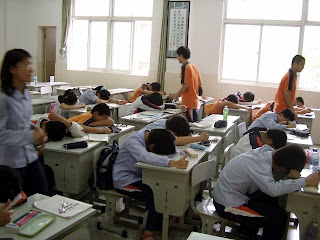 |
| Sourced from Zethus's blog |
wiktionary.org defines physical education as: An element of an educational curriculum concerned with bodily development, strength, physical co-ordination, and agility.
wikipedia.org has a page on physical activity that defines it as: any bodily activity that enhances or maintains physical fitness and overall health and wellness. It is performed for various reasons including strengthening muscles and the cardiovascular system, honing athletic skills, weight loss or maintenance, as well as for the purpose of enjoyment.
I think these definitions are generally accurate, but we talked about a few more things that should be considered. Obviously physical education has a curriculum associated with it. But it also has purposeful movement that will help students to develop skills and aptitudes in a variety of areas. It should encourage students to remain active throughout their lives, and it should help students develop social skills. This does not mean that physical activity does not have those components, but rather that there is more purpose or meaningful content included in education as opposed to activity.
The national association for sport and physical education or NASPE (based in the US) has a page devoted to outlining the differences. They say that : "A quality physical education program provides learning opportunities, appropriate instruction, meaningful and challenging content for all children" whereas "Physical activity is bodily movement of any type and may include recreational, fitness and sport activities"
These definitions are very similar to the ones posted above from wikipedia and wiktionary but the page on NASPE is more complete with details on what they consider instruction, meaningful content, and appropriate assessment as well as examples of physical activity. I found that page to be very helpful in understanding the differences.
The government of Alberta also has some information outlining the differences between physical fitness and physical activity. To start with, they say "quality physical education always includes physical activity, but the reverse isn’t always true." This is the same comparison as 'all squares are rectangles, but not all rectangles are squares'. Although there are some similarities and overlap between physical activity and physical education they are not one in the same.
Specifically, from the point of view of education,
The Alberta curriculum identifies four general outcomes for physical education (the ABCDs):
A: Activity
B: Benefits health
C: Co-operation
D: Do it daily … for life!
The Saskatchewan Curriculum does not have a cute acronym for the overarching goals of physical education but the general sentiments are the same.
The K-12 goals are broad statements identifying what students are expected to know and be able to do upon completion of study in a particular area of study. The goals of physical education are interdependent and are of equal importance. The three goals for students from Kindergarten to Grade 12 are:
- Active Living – Enjoy and engage in healthy levels of participation in movement activities to support lifelong active living in the context of self, family, and community.
- Skillful Movement – Enhance quality of movement by understanding, developing, and transferring movement concepts, skills, tactics, and strategies to a wide variety of movement activities.
- Relationships – Balance self through safe and respectful personal, social, cultural, and environmental interactions in a wide variety of movement activities.
 |
| 7-Up (sourced from The Pilver's blog) |
Again, although there is overlap between physical activity and physical education we can see there are also distinct differences. Unfortunately I think there are too many teachers who have not taken the time to read and understand the differences and think that anytime students are moving they are "doing phys ed". I have worked in classes where teachers didn't have access to the gym, or chose not to take students to the gym because they were too loud in the hall way last time, so they tried to do phys ed class in the classroom. What happened? Students usually ended up playing 7-up or four corners. Neither of which meets any of the curriculum goals. It might be fun for the students, but it is definitely not phys ed.
No comments:
Post a Comment